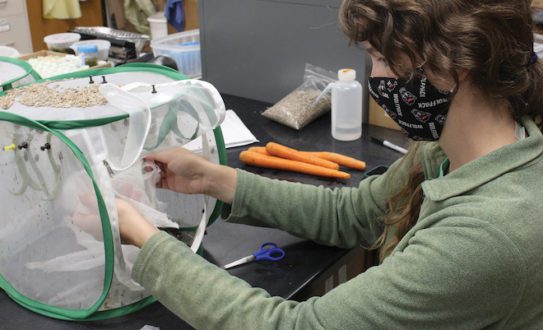

Dec 23, 2021Reduced insecticide, IPM programs are key
Reducing the need for broad spectrum insecticide use – primarily the pyrethroids and neonicotinoids – will foster beneficials, which is the long term strategy for brown marmorated stink bug (BMSB) control.
BMSB is an invasive bug that is a serious pest of fruit, vegetable and other crops.
“An insecticide program causes a disruption of the IPM program,” said Jim Walgenbach, professor and Extension entomology specialist for fruits and vegetables in North Carolina State University’s (NCSU) Department of
Entomology and Plant Pathology.
The broad spectrum use of insecticides is harmful to biological control agents and can cause outbreaks of secondary pests such as spider mites, scales, aphids and Western flower thrips. These insecticides can also be harmful to pollinators if not applied correctly.
“These secondary pests are all insects that to a degree can be managed by biological control,” Walgenbach said. Broad spectrum insecticide use can release these secondary pests from their biological controls. Pyrethroids can also induce secondary pests through effects on the pests’ behavior or physiology.
“Increased secondary pest populations lead to more use of different types of insecticides because biological control is no longer in effect,” Walgenbach said.
A collaborative BMSB Specialty Crop Research project with more than 40 researchers from 18 institutions across the U.S. is developing alternatives to the broad use of insecticides.
“The first and most useful tool is using pheromone traps to track pest populations, which leads to more efficient insecticide uses,” Walgenbach said.
Walgenbach serves as the project leader of the collaborative project, which is funded by the USDA’s Specialty Crop Research Initiative. The website StopBMSB.org is an outlet for the project’s progress. A main effort of the collaboration is to develop BMSB thresholds for different cropping systems across the country.
Attract and kill technology is another promising use of pheromones. The pheromones attract the BMSBs to a single location and that one location is treated with an insecticide. Insecticide-impregnated netting, instead of insecticide sprays, is also being evaluated as a killing agent of stink bugs. This has the potential to greatly reduce the amount of insecticide released into the environment.
“The netting is quite effective and lasts several years,” Walgenbach said.
Perimeter spraying has worked well in the northeastern U.S. where a lot of the BMSBs reside in woodlots and areas outside of the fields. The populations build in these locations and then disperse into agricultural crops.
The goal of reducing insecticide use is to foster beneficials and the first one that comes to mind is the samurai wasp (Trissolcus japonicus).
The samurai wasp is from Asia like the BMSB and was accidentally introduced to the U.S. like the BMSB.
“It evolved with the brown marmorated stink bug,” said Emily Ogburn, research associate in NCSU’s Department of Entomology and Plant Pathology.
The samurai wasp is able to pick up on chemical clues to find the BMSBs. “That’s why some of our native parasitoids aren’t that effective,” Ogburn said. “They attack the eggs, but at very low levels. The native parasitoids probably have trouble finding them.”
“The native parasitoids have not been very effective at parasitizing the brown marmorated stink bug,” Walgenbach said. “For the most part, they’re poorly adapted to BMSB eggs.”
Generalist predators like lady beetles and lacewings consume the eggs of many insect pests and stink bugs are one of the many pests they feed on.
The parasitoids like the samurai wasp are small, parasitic wasps that are more specialized.
“They feed on only certain species of insects or one insect family,” Walgenbach said. “They lay their eggs in the brown marmorated stink bug eggs and use the eggs to raise their progeny.”
The samurai wasp has been detected in 14 states and is becoming more widely established every year. USDA-APHIS regulations prohibit any release of samurai wasps in an area where it is not naturally established.
Stink bug parasitoids, including the samurai wasp, are not only specialized on the species of stink bugs they attack, but also on the habitat in which they reside. The samurai wasp seems to be adapted to wooded landscapes.
“In the eastern U.S., we haven’t yet seen a strong impact by the samurai wasp on brown marmorated stink bug populations, but it’s still relatively early in the establishment stage,” Walgenbach said.
Research continues on the redistribution and monitoring of the impact of samurai wasps.
“The adults feed on nectar from flowers,” Ogburn said, so planting flowers may aid establishment. What types of flowers are preferred is still unknown. In crops where insecticides must be regularly used, having an untreated refuge area for the samurai wasp adults will be important.
Nosema maddoxi is a microsporidium that is a beneficial pathogen with the potential for effective, biological control. Nosema maddoxi was first found in green stink bugs – a native species. It’s known to only infect two other native species – brown stink bug and dusky stink bugs – and BMSB.
“There’s a lot we don’t know,” Walgenbach said. “We know wherever we’ve looked for Nosema maddoxi in a brown marmorated stink bug population, we’ve found it. It’s epidemiology is being studied and it hopefully has great promise.”
Right now, the best management strategy for BMSB is to scout and treat if BMSBs are over threshold. “Know the biology in your area,” Walgenbach said. “Know when numbers typically are most often the highest. Brown marmorated stink bug is not a serious pest in our area until July or August, depending on elevation.”
“Integrate some strategies into management programs to help ensure the survival of the samurai wasp and other natural enemies,” Ogburn said.
“Use trapping and spray in those areas where you have potentially damaging populations,” Walgenbach said.
— Dean Peterson, FGN correspondent














